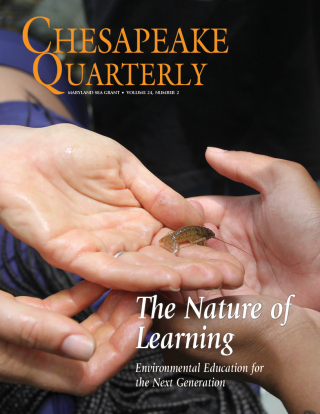Knauss legislative fellowships in Congress help build careers — and they're fun and educational. See our video and fact sheet for details.
The Maryland Sea Grant Bookstore will be closed for the winter holidays from Monday, December 15th to Friday, January 5th and will not be taking orders during that time.
R/AQ-11
Diversification of Maryland Shellfish Aquaculture: Development and Assessment of a Subtidal Grow-Out Method for Culture of Soft-Shell Clams (Mya arenaria)
Principal Investigator:
Ming LiuStart/End Year:
2022 - 2024Institution:
Morgan State UniversityCo-Principal Investigator:
Brittany Wolfe-Bryant, Jon Farrington, Scott Knoche, Amanda Knobloch, Morgan State University, PEARLTopic(s):
- Research Projects
Strategic focus area:
Sustainable fisheries and aquacultureDescription:
The Maryland shellfish aquaculture industry has grown rapidly in the last decade. However, the industry currently consists of only a single species, the Eastern oyster. The monoculture approach leaves the industry vulnerable to disease, climate change, and market fluctuations which pose threats to sustainable industry growth. The soft-shell clam (Mya arenaria) is a commercially important shellfish species harvested in Northeast U.S. coastal waters. This species can grow and reproduce in low salinity waters, which makes it a strong candidate species for culture in Maryland’s portion of the Chesapeake Bay. Further, several Maryland growers have stated their interest in culturing this species. Maryland’s limited intertidal zone necessitates the development of a suitable subtidal culture for this species. In this project, project PIs will partner with shellfish growers to develop and investigate six different culture methods under three design categories with the goal of identifying a feasible and cost-effective subtidal culture method. This project has the potential to diversity Maryland shellfish aquaculture product lines and expand opportunities for existing and new shellfish farmers in Maryland.
Impact/Outcome:
Project Accomplishments
To support a potential soft-shell clam aquaculture industry in Maryland Sea Grant-funded researchers tested grow-out methods in partnership with shellfish growers, created heat-resistant broodstock lines, and are publishing a manual to guide commercial shellfish operators interested in soft-shell clams.
Read more
Relevance Historically, Maryland was a top producer of soft-shell clams. It had some of the highest landings of soft-shell clams in the 1960s, before clam populations plummeted and the associated fishing industry dissolved. Potential exists to grow soft-shell clams through aquaculture in the Chesapeake Bay, although rising temperature and water quality changes have resulted in the need for new growing methods. This would provide growers with an additional bivalve to sell.
Response: Maryland Sea Grant-funded researchers have expanded their initial research about soft-shell clam seed and testing grow-out methods in partnership with Maryland aquaculture companies. The researchers have used heat-shock experiments to develop heat-resistant soft-shell clam seed that will be available to commercial growers this spring. The researchers are also developing a manual that will provide growers with instructions about different culture and grow-out methods.
Results: In ongoing grow-out tests, the clam lines developed by the research team have grown an average of 1.7-1.8 inches, with some clams exceeding two inches. These genetically selected soft-shell clams have a survival rate of close to 100 percent, which would provide aquaculture growers a promising new shellfish crop that is hardy against summer heat waves and would diversify their business. The research team has fielded inquiries from a Maryland hatchery interested in growing soft-shell clam seed as well as Maryland shellfish growers.





